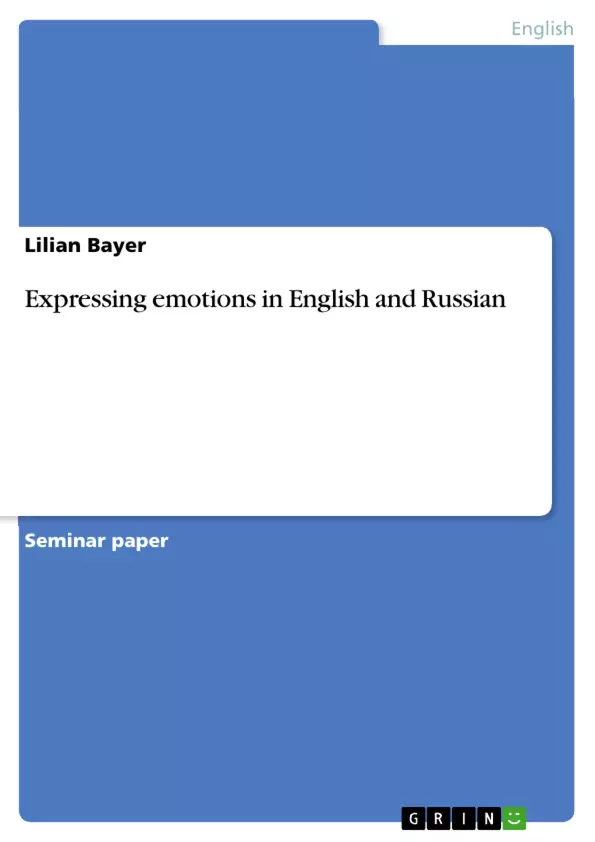1. Introduction
There is no better way to explore different cultures than through analysing the languages spoken by members of ethnical communities. Indeed, the best evidence for differences and similarities between people, as bearers and products of cultures, comes from languages. Besides body language and facial mimics, speech is essential for expression of thoughts or feelings and emotions for every human being. However, the way of expressing emotions differs from culture to culture and from continent to continent according to the indigenous values and norms of the persons concerned.
Anna Wierzbicka together with Cliff Goddard and their colleagues did linguistic research on many European and exotic languages, comparing them in order to find differences and similarities. They gained many interesting insights about the language as an “indicator” of culture, as it necessarily reflects on it. The Russians and the Anglo seem to be very different from each other as to expression of emotions due to their general attitude to having them and above all, to expressing them.
In order to provide an objective analysis for all languages which can be understood by everybody, a Natural Semantic Metalanguage based on semantic primitives, has been developed. This new mean allowed to produce cultural scripts and to develop “models of a person”, representing the culture-specific norms and values.
Further, in this work, the Natural Semantic Metalanguage and the Russian and Anglo models of a person are explained in greater detail. Finally, it concentrates on the linguistic evidence pertaining to expression of emotions in English and Russian.
[...]
Inhaltsverzeichnis (Table of Contents)
- Introduction
- Main Part
- Natural Semantic Metalanguage
- Model of a person: Anglo vs. Russian
- The centrality of emotions in Russian
- Joy
- Sadness
- Conclusion
Zielsetzung und Themenschwerpunkte (Objectives and Key Themes)
This work aims to analyze the expression of emotions in English and Russian, exploring the cultural differences and similarities in how these languages express and understand feelings. The author utilizes the Natural Semantic Metalanguage (NSM) to provide a framework for comparing the two languages and their respective cultural perspectives on emotions.
- Cultural differences in expressing emotions
- The role of language in reflecting culture
- The Natural Semantic Metalanguage as a tool for cross-cultural understanding
- The "model of a person" as a cultural concept
- Specific examples of emotional expression in English and Russian
Zusammenfassung der Kapitel (Chapter Summaries)
The introduction establishes the importance of language in understanding culture, highlighting the differences in emotional expression across cultures. It introduces the work of Anna Wierzbicka and her colleagues, who developed the Natural Semantic Metalanguage (NSM) for analyzing languages and their cultural implications. The introduction also highlights the contrasting approaches to emotions in Anglo and Russian cultures.
The main part delves into the NSM, explaining its origins, methodology, and core concepts. The NSM is presented as a tool for analyzing languages from a culture-internal perspective, focusing on the meanings that are significant within the language itself. The chapter explores the use of semantic primes in the NSM and their application in understanding cultural differences.
The chapter then introduces the concept of the "model of a person" as a cultural construct that reflects the values and norms of a particular culture. The author compares the Anglo and Russian models of a person, highlighting the different ways in which emotions are understood and expressed in these cultures. The chapter concludes with specific examples of emotional expression in English and Russian, providing insights into how language reflects cultural values and attitudes towards emotions.
Schlüsselwörter (Keywords)
This work focuses on the key concepts of cultural differences in expressing emotions, the Natural Semantic Metalanguage (NSM), semantic primes, the model of a person, English and Russian languages, and cultural pragmatics.
- Quote paper
- Lilian Bayer (Author), 2009, Expressing emotions in English and Russian, Munich, GRIN Verlag, https://www.grin.com/document/140346



